Volume 13, Issue 2
Displaying 1-6 of 6 articles from this issue
- |<
- <
- 1
- >
- >|
Special Issue: Ten years’ Experience of the Policy Evaluation System in Japanese Central Government ~Reviews and Experience~
-
2013Volume 13Issue 2 Pages 1-2
Published: November 22, 2013
Released on J-STAGE: June 01, 2023
Download PDF (499K) -
2013Volume 13Issue 2 Pages 3-19
Published: November 22, 2013
Released on J-STAGE: June 01, 2023
Download PDF (623K) -
2013Volume 13Issue 2 Pages 21-36
Published: November 22, 2013
Released on J-STAGE: June 01, 2023
Download PDF (563K) -
2013Volume 13Issue 2 Pages 37-52
Published: November 22, 2013
Released on J-STAGE: June 01, 2023
Download PDF (683K) -
2013Volume 13Issue 2 Pages 53-67
Published: November 22, 2013
Released on J-STAGE: June 01, 2023
Download PDF (554K)
Report
-
2013Volume 13Issue 2 Pages 69-82
Published: November 22, 2013
Released on J-STAGE: June 01, 2023
Download PDF (2985K)
- |<
- <
- 1
- >
- >|
